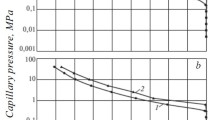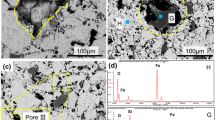Abstract
Savonnières, a French layered oolithic limestone, shows important ink-bottle effects. As a consequence, a great discrepancy is observed between the results of different techniques to determine the pore volume distribution. It is shown that mercury intrusion porosimetry results can be considered as the main drainage curve and are, for this kind of materials, not convenient to determine the apparent pore volume distribution due to hysteresis phenomena. The main wetting curve is obtained using image analysing techniques on SEM-micrographs, combined with pressure membrane apparatus results on capillary saturated samples.
A simple structural hysteresis model is developed to predict the mercury intrusion porosimetry results, starting from the main wetting curve. The good agreement between theory and experiment verifies that the large difference between main wetting and main drainage curve can indeed be attributed to structural hysteresis. In this way, the presented technique gives, in addition to a better knowledge of the pore volume distribution, insight in the pore geometry and connectivity, which can serve as input for microstructure-based transport models.
Résumé
La courbe de rétention d'eau et la courbe de distribution volumique des pores obtenues au moyen de la porosimétrie à intrusion de mercure (PIM), de l'appareil à membrane de pression et des techniques d'analyse d'images sur micrographe-MEB sont comparées pour la pierre de Savonnières, une roche calcaire oolithique plus ou moins stratifiée en provenance de la France. Le matériau montre d'importants effets «bouteille d'encre». Il est démontré que les résultats obtenus par PIM peuvent être considérés comme courbe principale de drainage et ne peuvent pas être utilisés, pour ces matériaux, pour déterminer la distribution volumique apparente des pores en raison de phénomènes d'hystérésis. La courbe principale de mouillage est obtenue par des techniques d'analyse d'images sur micrographe MEB, combinées avec les résultats de l'appareil à membrane de pression sur des échantillons saturés par capillarité.
Un modèle structurel simple d'hystérésis est développé; il est capable de prédire les résultats obtenus par porosimétrie à intrusion de mercure au départ de la courbe principale de mouillage. Ceci permet de vérifier que la grande différence entre les courbes principales de mouillage et de drainage peut en effet être attribuée aux hystérésis de structure. Comme conséquence, la méthode présentée donne, outre une meilleure connaissance de la distribution volumique des pores, un aperçu de la géométrie des pores et de la connectivité, ce qui peut servir de données en entrée pour des modèles de transfert basés sur la microstructure.
Similar content being viewed by others
References
Marchand, J. and Gerard, B., ‘Microstructure-based models for predicting transport properties’, in Rilem Report 16: Penetration and Permeability of Concrete. Barriers to organic and contaminating liquids’, edited by H. W. Reinhardt (E&FN Spon, London, 1997) 41–81.
Sahimi, M., ‘Flow phenomena in rocks: from continuum models to fractals, percolation, cellular automata and simulated annealing’,Reviews of Modern Physics 65 (1993) 1393–1534.
Carmeliet, J., Descamps, F. and Houvenaghel, G., ‘A multiscale network model for simulating moisture transfer properties of porous media’,Transport in Porous Media 35 (1999) 67–88.
Van Brakel, J., Modrý, S. and Svata, M., ‘Mercury porosimetry: state of the art’,Powder Technology 29 (1981) 1–12.
Cook, R. A. and Hover, K. C., ‘Mercury porosimetry of cement-based materials and associated correction factors’,Construction and Building Materials 7 (1993) 231–240.
Metz, F. and Knöfel, D., ‘Systematic mercury porosimetry investigations on sandstones’,Mater. Struct. 25 (1992), 127–136.
Wardlaw, N. C. and McKellar, M., ‘Mercury porosimetry and the interpretation of pore geometry in sedimentary rocks and artificial models’,Powder Technology 29 (1981) 127–143.
Dullien, F. A. L. and Mehta, P. N., ‘Particle size and pore (void) size distribution determination by photomicrographic methods’,Powder Technology 5 (1971) 179–193.
Dullien, F. A. L. andDhawan, G. K., ‘Characterization of pore structure by a combination of quantitative photomicrography and mercury porosimetry’,Journal of Colloid and Interface Science 47 (2) (1974) 337–349.
Abell, A. B., Willis, K. L. and Lange, D. A., ‘Mercury porosimetry and image analysis of cement-based materials’,Journal of Colloid and Interface Science 211 (1) (1999) 39–44.
Lange, D. A., Jennings, H. M. and Shah, S. P., ‘Image analysis Techniques for characterization of pore structure of cement-based materials’,Cement and Concrete Research 24 (5) (1994) 841–853.
Bear, J. and Bachmat, Y., ‘Introduction to Modelling of Transport Phenomena in Porous Media’ (Kluwer, Dordrecht, the Netherlands, 1990).
Underwood, E. E., ‘Quantitative Stereology’ (Addison-Wesley, Reading, 1970).
Roels, S., Elsen, J., Carmeliet, J. and Hens, H., ‘Microscopic analysis of imbibition processes in oolithic limestone’,Geophysical Research Letters 27 (21) (2000) 3533–3536.
Haynes, J. M., ‘Pore size analysis according to the Kelvin equation’,Mater. Struct. 6 (33) (1973) 209–213.
Durner, W., ‘Hydraulic conductivity estimations for soils with heterogeneous pore structure’,Water Resources Research 30 (1994) 211–223.
Mualem, Y., ‘A conceptual model of hysteresis’,Water Resources Research 10 (3) (1974) 514–520.
Roels, S., ‘Modelling unsaturated moisture transport in heterogeneous limestone’, Ph.D. Thesis, Leuven. (Catholic University of Leuven, Belgium, 2000).
Author information
Authors and Affiliations
Rights and permissions
About this article
Cite this article
Roels, S., Elsen, J., Carmeliet, J. et al. Characterisation of pore structure by combining mercury porosimetry and micrography. Mat. Struct. 34, 76–82 (2001). https://doi.org/10.1007/BF02481555
Received:
Accepted:
Issue Date:
DOI: https://doi.org/10.1007/BF02481555




